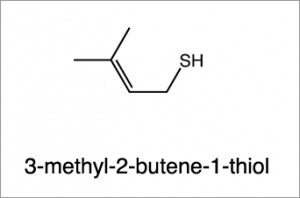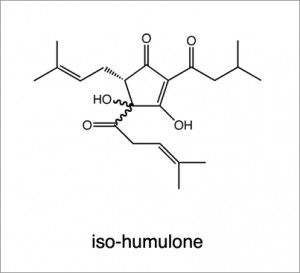The Chemistry of Skunky Beer
by
 Pepé le Pew: funny. Beer: delicious.
Pepé le Pew: funny. Beer: delicious.
Pepé le Pew in your booze? Not funny OR delicious.
Occasionally, you may hear friends complain of “skunky beer” – but what does that mean? Is it just slang for a terrible brew? Did they just insult your drink? Actually, there is some truth to the term, and a little bit of chemistry helps make sense of it.
Frighten a skunk, and you’ll be covered in 3-methyl-2-butene-1-thiol in no time. You’ll also be eating alone for the next few days. When beer goes bad, this thiol is generated, thus giving beer the literal odor of skunk.
So where does it come from? Unfortunately, the source is the main ingredient that gives beer great taste- hops. In brewing, the blossoms of the hops flower are added to balance the sweet taste produced by the malt. Among a number of compounds present in hops is iso-humulone. Upon exposure to light, iso-humulone is hydrolyzed producing an active electrophile. Nucleophilic thiols present in the brew then react with the electrophilic fragment to give the odorous 3-methyl-2-butene-1-thiol.
 To prevent beers from “skunking”, manufacturers bottle the suds in brown glass, which filters out the wavelengths responsible for the hydrolysis reaction. Some brewers have also attacked the problem by hydrogenating iso-humulone, which yields a light-stable derivative that is amenable to bottling in clear glass. But as with any synthesis, an extra step usually just decreases your yield and increases your cost, so that’s why we see most of our cherished brews in brown bottles.
To prevent beers from “skunking”, manufacturers bottle the suds in brown glass, which filters out the wavelengths responsible for the hydrolysis reaction. Some brewers have also attacked the problem by hydrogenating iso-humulone, which yields a light-stable derivative that is amenable to bottling in clear glass. But as with any synthesis, an extra step usually just decreases your yield and increases your cost, so that’s why we see most of our cherished brews in brown bottles.
So next time you’re at a BBQ and your beer slides down a little too fast, let your friends know you’re just trying to reduce the amount of iso-humulone hydrolysis by getting your booze out of the light as soon as possible!


Recipes: Chemistry You Can Eat | BenchFly Blog
wrote on December 2, 2010 at 10:04 pm
[…] Chemistry of Skunky Beer – Yes, skunky beer really exists so next time it comes up with friends, drop some chemistry on them […]